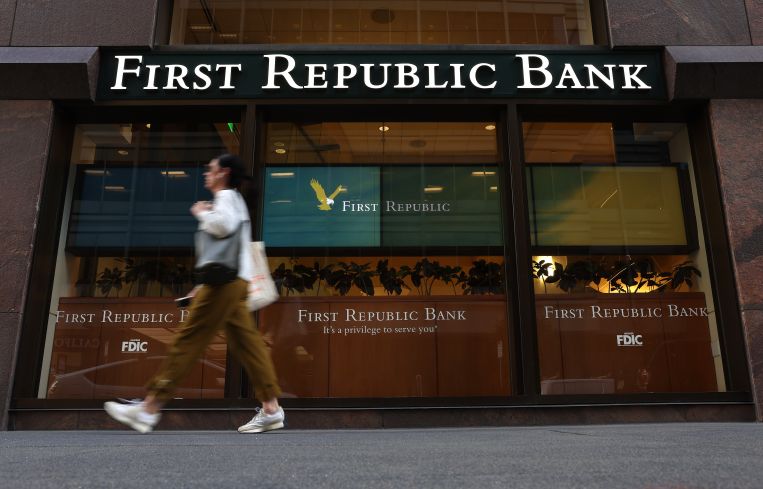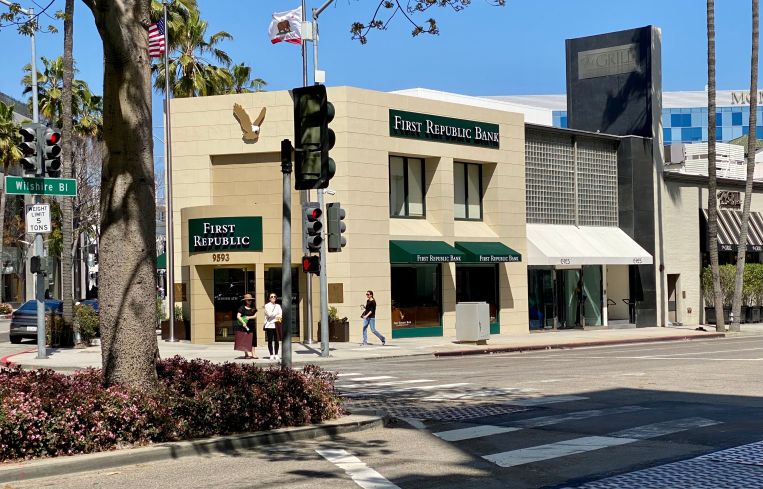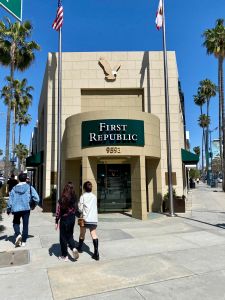JPMorgan Chase’s First Republic Bank Takeover Rattles Capital Markets
Why economists believe First Republic’s failure isn’t the end of the regional banking crisis
By Brian Pascus May 1, 2023 2:37 pm
reprints

The second-largest commercial bank failure in American history has shocked capital markets and created concern among economists that the U.S. banking system might be on the verge of a more widespread crisis.
JPMorgan Chase (JPM) purchased First Republic Bank (FRCB) at the behest of federal regulators on Monday, ending the rumor mill that reached fever pitch late last week and completing the stunning collapse of what was the 14th-largest bank in the U.S. at the start of the year.
Despite holding more than $176 billion in deposits at the end of 2022, First Republic reported in mid-April that it saw deposit outflows of $102 billion in the first three months of the year, much of it occurring in March following the demise of Silicon Valley Bank (SIVBQ) (SVB) and Signature Bank (SBNY), events that set off an ongoing regional banking crisis.

In all three bank failures, skittish depositors pulled out billions of dollars in what amounted to a classic run sparked by concerns about balance sheet viability and asset-price valuations amid rising interest rates. The Federal Reserve has raised its benchmark Federal Funds Rate roughly 5 percent over the last 13 months, the swiftest rate increase in 17 years.
Now economists are worried other regional banks across the U.S. are at risk of runs similar to what befell First Republic, SVB and Signature Bank.
“The regulators would like to say, ‘We’re done and the system is safe,’ but by our calculations close to 200 other banks can fail, many which are smaller [than First Republic],” said Tomasz Piskorski, professor of real estate at Columbia Business School. “The issues aren’t over.”
Chief among the risks to the banking system is the ongoing rise in interest rates engineered by the Fed to combat inflation. While higher interest rates can tame inflation by cooling down the economy, leading to a decline in consumer prices, they can also be fatal to banks.
“There’s a lot of risk in the banking system because there’s hundreds of banks that have the current market value of assets less than the face value of debt, and [the crisis] is mainly caused by the interest rate increase by the Fed,” explained Piskorski. “If asset values of banks decline, most banks remain solvent so long as depositors don’t ask for money or they pay the higher deposit rate. But close to half of deposits are uninsured, so if they see a bank on the brink of insolvency, they may withdraw their money.”
Joel Naroff, an economist in the tri-state area at consulting firm Naroff Economics, said all three of the recently deceased banks made the same fatal mistake in how they structured their balance sheets: They bet on low interest rates for an extended period of time.
“Had they started betting on it 10 years ago, they’d be OK, but they kept betting on it year after year after year,” Naroff said. “That was their mistake.”
For commercial real estate, the concern is how the demise of First Republic will impact the outstanding loans made to borrowers in a field that is already reeling from an uncertain capital markets environment.
First Republic’s balance sheet reveals a firm with modest commercial real estate exposure.
By the end of 2022, First Republic’s commercial real estate loans stood at $10.8 billion, or 6 percent of the firm’s loan portfolio, with an average CRE loan commitment size of $4 million, according to the firm’s 2022 annual report. Total loan originations were $73.4 billion in 2022, compared to $64.8 billion in 2021, and $52.7 billion in 2020.
“Loan originations increased in 2022 primarily due to increases in single-family, multifamily and commercial real estate lending,” the firm’s annual report said.
Seth Weissman, managing partner at Urban Standard Capital, an alternative lender, said First Republic was his firm’s biggest competitor when it came to private real estate lending in the Hamptons and that First Republic was also a large player in the private equity financing space, the fund financing business, and the jumbo mortgage business.
“It definitely leaves a gap in the market that is a net negative,” Weissman said. “To lose a major player in those spaces will just reduce the number of options that are available.”
Weissman added, however, that he expects alternative lending in the single-family and luxury construction divisions to pick up now that First Republic has gone under.
Similarly, Manish Shah, senior managing director at Palladius Capital Management, a real estate investment firm, said that debt funds like his company are well suited to fill the gap left by a contraction of credit from the regional banking sector.
“Many actors like us, and in private credit, have a good matching of duration and long-term capital, therefore we can do one- to three-year loans because we’re not levered,” explained Shah. “And most competitors of ours [in the private credit space] have modest leverage, much less than regional banks.”
Shah added that more bank collapses and office loan defaults brought on by borrowers turning in their keys could be on the horizon, but it’s nothing that should be viewed as a systemic problem in the same way a wave of real estate defaults presaged the Global Financing Crisis that hit in 2007.
“There will be headlines, but that almost seems like a healthy part of an economy reinventing itself,” he said.
But multiple economists have cautioned against viewing the current banking upheaval as just another part of a healthy economy finding its balance amid higher interest rates. Piskorski and Naroff both said the ingredients are in place for a repeat of the savings and loan financial crisis of the late 1980s that helped set off the recession in the early 1990s.
Then, as now, the banks borrowed short through deposits and lent long on maturities, mostly mortgages, Naroff explained. But with an abrupt jump in interest rates, S&Ls had to pay up in the market on their long-term loans, while their assets had declined sharply in value.
“Whether it was Silicon Valley Bank or First Republic Bank, they all made the same mistake: They became a [S&L],” Naroff said.
Piskorski emphasized that the persistence of higher interest rates today could set off mortgage defaults in the CRE sector similar to the way the wave of defaults on home mortgages sank S&Ls 30 years ago, as a large portion of the S&L’s asset base were in fixed-rate mortgages.
“There’s a very significant risk and the problems won’t go away,” Piskorski said. “If rates remain elevated, and if we have defaults or distress on loans due to CRE defaults, or even a wave of office defaults, then this could be a repeat of the [S&L] crisis.”
Even professor Lawrence J. Wright, an economist at New York University, who said he doesn’t see further repercussions in First Republic’s collapse, said that the similarities between the regional banks today and the S&Ls then are “spot on” in the formula of borrowing short, lending long, and holding a large portion of balance sheet value in uninsured deposits subject to a sudden bank run.
“The important question is will the Fed, the Treasury and the FDIC give these guys time to do a Hail Mary pass to work off that underwater portfolio, maintain depositor confidence, and eventually turn things around?” Wright said. “The next important step will be the second-quarter earnings reports announced in July.”
But there might not be enough time for other regional banks to shore up their balance sheets before the walking wounded of the financial industry are revealed.
In fact, they might already be dead men walking.
“We have zombie banks,” said Piskorksi. “They are on the brink of insolvency and the depositors just haven’t run yet.”
Brian Pascus can be reached at bpascus@commercialobserver.com


